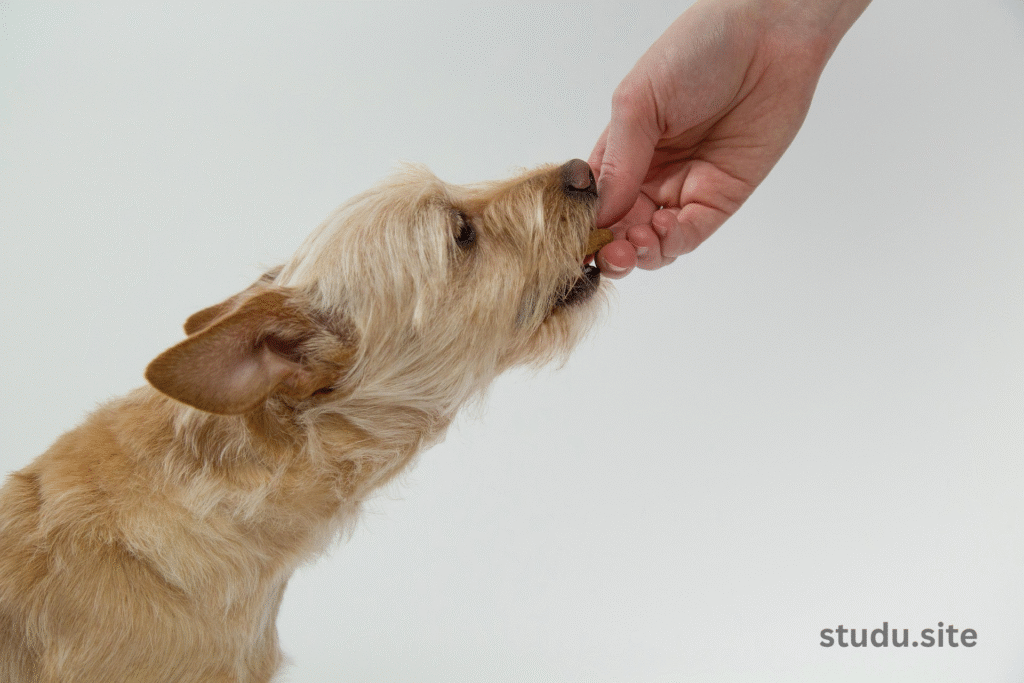Introduction to Can Dogs Eat Popcorn?
You, as a pet owner, have probably asked yourself, “Can dogs eat popcorn?” Popcorn has become a common snack for movie nights and parties, and it’s hard not to want to give your pet a few kernels. In 2025, with pet nutrition trends shifting and sites such as X abuzz with pet care advice under such hashtags as #DogDiet and #PetNutrition, knowing what’s safe for canines is essential.
This in-depth guide delves into whether dogs can eat popcorn safely, the pros and cons, how to make it, and expert-supported tips to keep your dog healthy and happy.

Is Popcorn Safe for Dogs?
The short answer is yes, dogs may have popcorn in moderation, provided that it’s plain, air-popped, and additive-free. Plain popcorn is non-toxic to dogs and can serve as a low-calorie treat if dispensed in moderation, as states the American Kennel Club (AKC). As 66% of U.S. homes currently own pets, according to the American Pet Products Association in 2024, providing safe treats has never been more vital.
Popcorn is rich in fiber, carbohydrates, and trace amounts of iron and magnesium, which can supplement a dog’s well-balanced diet. However, the preparation and serving of popcorn have considerable effects on its safety. Let’s discuss the important factors.
Advantages of Popcorn for Dogs
When prepared properly, popcorn provides possible advantages for canines:
-
Low-Calorie Snack: Air-popped popcorn contains around 31 calories per cup, which is a less fat-laden treat than high-fat dog treats.
-
Fiber Source: Popcorn fiber can support digestion, facilitating dogs with occasional constipation.
-
Mental Stimulation: Sprinkling a handful of kernels can stimulate a dog’s foraging behavior, as observed in X posts with #DogEnrichment suggestions.
-
Budget-Friendly and Readily Available: Popcorn is an inexpensive treat, readily available to pet owners.
Nonetheless, these advantages are low compared to a dog’s regular diet, which ought to be high-quality, nutritionally complete dog food.
Risk of Giving Popcorn to Dogs
Although plain popcorn is harmless, some preparations and situations are dangerous:
-
Unpopped Kernels: Hard, unpopped kernels may break teeth or lead to choking, particularly in small breeds such as Chihuahuas.
-
Additives: Butter, salt, oil, or seasonings (e.g., cheese powder, caramel) are toxic. Salt can cause sodium ion poisoning, resulting in vomiting or seizure, according to the Merck Veterinary Manual.
-
High-Fat Content: Popcorn from the movie theater or microwave, usually drizzled with butter or oil, can initiate pancreatitis in dogs, a condition that needs to be treated by a veterinarian.
-
Digestive Issues: Excessive popcorn consumption can lead to bloating or stomach upset, especially in dogs with sensitive digestion.
-
Allergies: While unlikely, some dogs are allergic to corn and develop itching or gastrointestinal upset.
Always consult your veterinarian before introducing popcorn, especially for dogs with health conditions like obesity or diabetes.
How to Safely Feed Popcorn to Dogs
To ensure popcorn is safe for your dog, follow these preparation and feeding guidelines:
1. Choose Plain, Air-Popped Popcorn
-
Use an air popper or stovetop method without oil or butter.
-
Avoid microwave popcorn, which often contains hidden fats or seasonings.
-
Check for unpopped kernels and remove them to prevent choking.
2. Serve in Moderation
-
Serve popcorn as an occasional reward, not a regular snack.
-
The AKC suggests treats comprise no more than 10% of a dog’s total daily calories. For a 50-pound dog, 1–2 cups of plain popcorn (31–62 calories) is sufficient.
-
Adjust quantities according to your dog’s size: small dogs (such as Yorkies) receive only a few kernels, while larger dogs (such as Labradors) can receive more.
3. Look for Reactions
-
Slowly introduce popcorn, beginning with 1–2 kernels.
-
Observe for signs of gastrointestinal distress, such as diarrhea or vomiting, and discontinue feeding if these symptoms occur.
-
Look for signs of allergy, including itching or ear infections, and consult a veterinarian if symptoms are experienced.
4. Refrain from Unsafe Additives
-
Avoid toppings such as butter, salt, sugar, or artificial flavors.
-
Never use seasonings such as garlic or onion powder, toxic to dogs, according to the ASPCA.
-
Look up X for #DogSafeTreats to discover pet owner advice on safe popcorn making.
Breed and Health Concerns
Some dogs will have special requirements:
-
Small Breeds: Chihuahuas or Pomeranians are at greater risk of choking, so crunch popcorn into very small pieces.
-
Older Dogs: Older dogs with dental problems must steer clear of hard kernels to avoid damaging their teeth.
-
Overweight Pets: Use limited popcorn to prevent excess calories since obesity occurs in 56% of dogs, according to a 2024 Banfield Pet Hospital report.
-
Allergy Dogs: Corn allergies, although rare, need vet diagnosis before serving popcorn.
Talk to your vet to create customized popcorn treats for your dog’s breed and health.
Substitutes for Popcorn for Dogs
If popcorn is not the best fit for your pet, use these dog-friendly treats:
-
Carrots: Low-calorie, crunchy, high-fiber, and high-vitamin.
-
Apple Slices: Core-free and seedless, apples are safe and sweet.
-
Green Beans: Low-calorie and filling, ideal for weight control.
-
Commercial Dog Treats: Select vet-approved brands such as Zuke’s Mini Naturals, which were trending in 2025.
Visit X to find #DogTreatIdeas for inspiration on creative, healthy snack recipes.
Common Myths About Dogs and Popcorn
-
Myth: Popcorn is always toxic to dogs.
Fact: Air-popped, plain popcorn is fine in moderation, but toppings make it hazardous. -
Myth: Any dog can have unlimited popcorn.
Fact: Overfeeding leads to digestive problems, and certain dogs experience corn allergies. -
Myth: Popcorn can be eaten as a complete meal substitute.
Fact: It’s a snack, not a meal replacement for well-balanced dog food.
Expert Advice for Safe Feeding of Popcorn
Veterinarians and pet nutritionists have these recommendations:
-
Dr. Sarah Wooten, DVM: “Popcorn can be a fun treat, but keep it plain and sparse. Always prioritize a complete diet.”
-
Pet Nutritionist Anette Lunde: “Use popcorn as training treats, but limit it to less than 10% of daily calories.”
-
X Community: Members such as @DogMomLife recommend combining popcorn with dog-safe peanut butter for a tasty treat.
Where to Learn More About Dog-Safe Foods
Grow your knowledge with these sources:
-
AKC.org: Provides in-depth descriptions of dog-safe human foods.
-
ASPCA.org: Identifies toxic and safe pet foods.
-
X Posts: Follow #PetNutrition for live advice from dog owners.
-
Veterinary Blogs: Websites such as PetMD give professional dog diet recommendations.
Conclusion
Dogs can safely eat popcorn if it is plain, air-popped, and provided in moderation. Although it has some slight benefits such as fiber and low calorie, risks such as choking, gastrointestinal problems, or toxic additives need proper preparation. By following our guide—choosing the right popcorn, monitoring portions, and consulting your vet—you can treat your dog without compromising their health.
In 2025, pet owners are sharing creative feeding tips on X with #DogSafeTreats, making it easier to keep your pup happy. For more pet nutrition advice, visit akc.org or connect with local dog communities. Enjoy sharing a safe snack with your furry friend!
